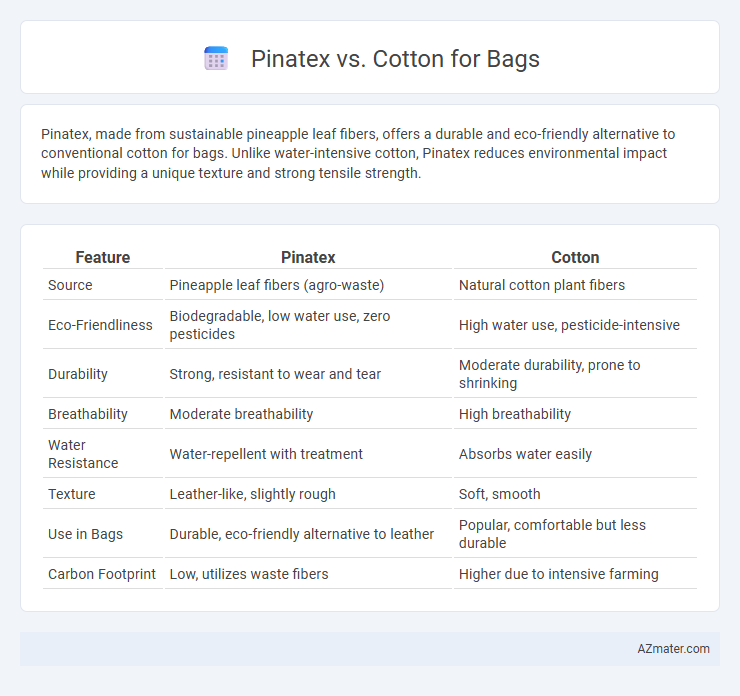Pinatex, made from sustainable pineapple leaf fibers, offers a durable and eco-friendly alternative to conventional cotton for bags. Unlike water-intensive cotton, Pinatex reduces environmental impact while providing a unique texture and strong tensile strength.
Table of Comparison
| Feature | Pinatex | Cotton |
|---|---|---|
| Source | Pineapple leaf fibers (agro-waste) | Natural cotton plant fibers |
| Eco-Friendliness | Biodegradable, low water use, zero pesticides | High water use, pesticide-intensive |
| Durability | Strong, resistant to wear and tear | Moderate durability, prone to shrinking |
| Breathability | Moderate breathability | High breathability |
| Water Resistance | Water-repellent with treatment | Absorbs water easily |
| Texture | Leather-like, slightly rough | Soft, smooth |
| Use in Bags | Durable, eco-friendly alternative to leather | Popular, comfortable but less durable |
| Carbon Footprint | Low, utilizes waste fibers | Higher due to intensive farming |
Introduction: Piñatex vs Cotton Bags
Pinatex bags, made from pineapple leaf fibers, offer a sustainable and eco-friendly alternative to traditional cotton bags, reducing water consumption and pesticide use significantly. Cotton bags, while natural and biodegradable, require intensive agricultural resources including large amounts of water and chemicals during cultivation. The durability and texture of Pinatex provide a unique vegan leather substitute that aligns with environmentally conscious fashion trends.
Material Origins and Production Processes
Pinatex, made from pineapple leaf fibers, is an innovative, sustainable alternative to traditional cotton used in bags, sourced as a byproduct of existing pineapple agriculture without additional land or water demands. Cotton cultivation requires extensive water, pesticides, and labor resources, contributing to environmental degradation and higher carbon footprints. Pinatex production involves minimal chemical treatments and supports waste valorization, while cotton undergoes intensive farming and processing involving ginning, bleaching, and dyeing, highlighting the eco-friendly advantage of Pinatex in sustainable bag manufacturing.
Environmental Impact Comparison
Pinatex, made from pineapple leaf fibers, offers a sustainable alternative to traditional cotton by utilizing agricultural waste and reducing water consumption by over 90% compared to cotton cultivation. Cotton farming requires significant pesticide use and extensive land, contributing to soil degradation and high carbon emissions, whereas Pinatex production supports circular economy principles with lower environmental footprint. Choosing Pinatex over cotton for bags significantly decreases water usage, chemical inputs, and greenhouse gas emissions, making it a more eco-friendly material for fashion and accessories.
Durability and Longevity
Pinatex, made from pineapple leaf fibers, offers excellent durability with resistance to abrasion and wear, making it a sustainable yet long-lasting alternative to traditional cotton. Cotton bags, while soft and breathable, tend to weaken and fade after repeated use and washing, reducing their overall longevity. The natural reinforcement in Pinatex fibers contributes to extended bag life, ideal for consumers seeking eco-friendly materials without compromising durability.
Aesthetic Qualities and Texture
Pinatex offers a unique, natural texture resembling woven fibers with a slightly rough yet flexible surface, giving bags a distinctive eco-friendly aesthetic. Cotton provides a soft, smooth feel with a matte finish, allowing for versatile dyeing and printing options that enhance visual appeal. Both materials balance durability and design versatility, but Pinatex stands out for its organic, textured look, while cotton excels in softness and customization.
Weight and Comfort
Pinatex offers a lightweight alternative to traditional cotton, making bags easier to carry without compromising durability. Its natural pineapple leaf fibers provide breathability and flexibility, enhancing user comfort compared to the denser, heavier cotton fabric. Pinatex bags also maintain shape and resist creasing, ensuring long-lasting comfort during extended use.
Cost and Market Availability
Pinatex, a sustainable alternative made from pineapple leaf fibers, generally costs more than conventional cotton due to its eco-friendly production process and smaller-scale manufacturing. Cotton remains widely available and cost-effective because of its extensive global cultivation and established supply chains, making it the dominant material for bags in the mass market. However, Pinatex is rapidly gaining market presence in niche and premium eco-conscious segments seeking sustainable materials despite higher prices.
Maintenance and Care Requirements
Pinatex bags require minimal maintenance, needing only gentle wiping with a damp cloth to remove dirt and occasional conditioning with natural oils to maintain flexibility and prevent cracking. In contrast, cotton bags often need regular washing to remove stains and odors, which can cause shrinkage or weakening of fibers over time. Pinatex's durability and water resistance make it a low-maintenance, sustainable alternative to the frequent upkeep cotton demands.
Ethical and Social Considerations
Pinatex, derived from pineapple leaf fibers, offers a sustainable alternative to cotton by utilizing agricultural waste that supports rural farming communities and reduces environmental impact. Cotton production often involves high water usage, pesticide application, and labor challenges, raising ethical concerns about worker exploitation and ecological strain. Choosing Pinatex promotes eco-friendly practices and social empowerment through fair-trade opportunities, contrasting with the traditional cotton industry's environmental and social footprint.
Choosing the Best Material for Your Bag
Pinatex, made from pineapple leaf fibers, offers a sustainable and cruelty-free alternative to traditional cotton, known for its natural breathability and softness. While cotton bags provide durability and ease of maintenance, Pinatex stands out for its eco-friendly production process and unique texture that enhances bag aesthetics. Choosing the best material depends on prioritizing environmental impact and design innovation versus classic comfort and widespread availability.

Infographic: Piñatex vs Cotton for Bag
 azmater.com
azmater.com